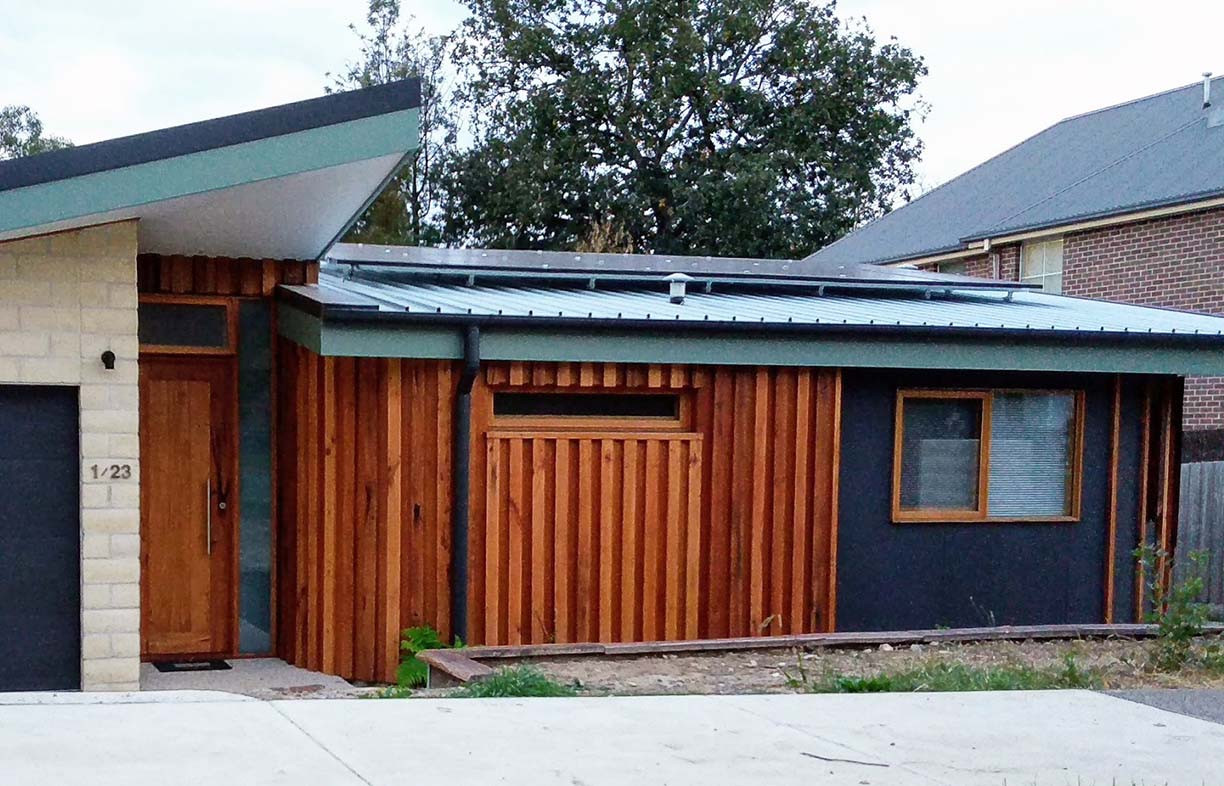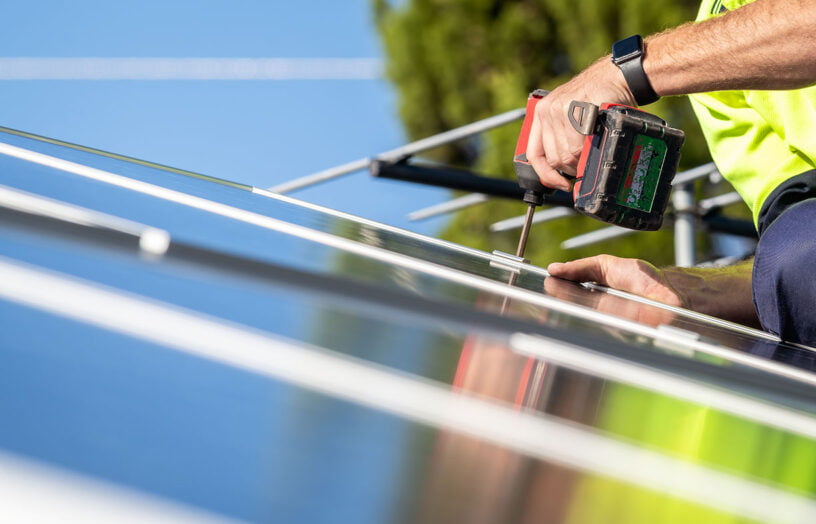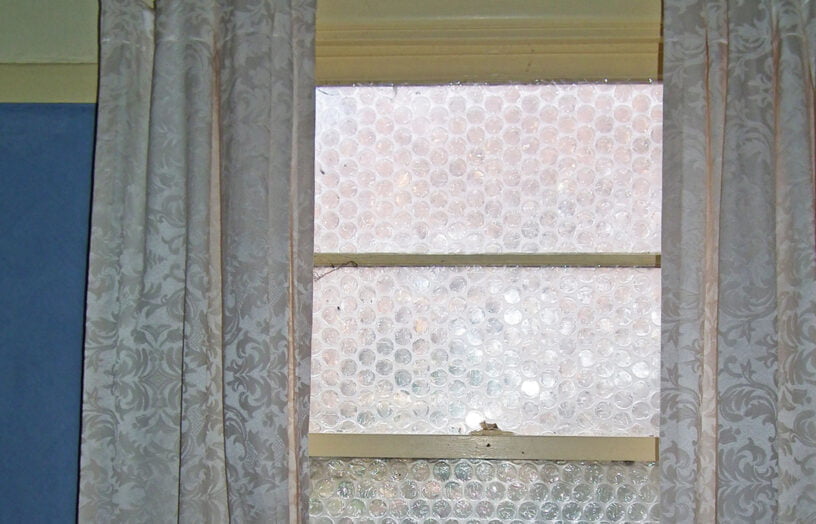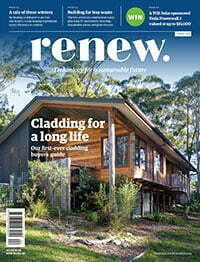Cladding case study: Cladding connections

This home in Melbourne has cladding made from beautiful 1960s timber, reused from the house that stood on the site before, combined with Colorbond and Shadowclad ply.
For their green building development of three homes in Melbourne, Howard and Libby Elston selected cladding to best fit several requirements: low maintenance, recycled or recyclable materials, aesthetics and cost.
They relied a great deal on the experience and expertise of their builder David from Sustainable Building and Design. “He has a good eye for how to create an attractive finish as well as the necessary installation skills,” says Howard.
Dismantling the original house on the block produced a great deal of usable timber that they wanted to recycle rather than waste. “This is timber that was milled in the early 1960s from trees that were probably hundreds of years old and has beautiful textures and colours,” says Howard. Because the wood looked so good, they decided to use it in a board and batten design near the front door (which is also made from reclaimed timber). They also like that it gives the new house a connection to the old.
Their next decision was to use Colorbond steel in an “interesting profile” (one normally used for roofing rather than cladding) for the eastern and western walls. They chose it as a long-lasting, low-maintenance option. “The western wall takes a fair bit of punishment from the summer sun and we wanted it to be ‘set and forget’,” says Howard. Steel also ticked the box of a product that can be easily recycled at the end of its life.
For the remaining sections of cladding, they chose Shadowclad, a plywood product, particularly for its ease of installation around the curved wall they’d designed for the second bedroom. “We also felt that using plywood made from plantation pine was a sustainable option,” says Howard. Aesthetically, it provides a plain background to other standout features of the house such as the contoured look of the Colorbond and the honey colour of the reclaimed wood.
Howard notes that when it comes to using reclaimed timber, although the product is free, there’s quite a lot of manual labour involved. This starts with taking care to remove the timber without too much damage, not just knocking down the house.
There was no shortage of reclaimed timber for the three houses they’re building: “Our builder commented that the old house must have been built by enthusiastic amateurs as there was way more timber in the frame than required by standard designs!” They avoided any issues with lead paint by only reusing unpainted framing timber and floorboards.
The cladding timber went offsite to the builder’s workshop to be prepared for installation (“which adds to the cost,” says Howard). The boards were denailed, cleaned and sanded: “We didn’t make any attempt to iron out imperfections as this would remove the history and character, and nobody worried about rough edges on the floorboards as they are covered by the battens.” Timbers for the battens were run through the ‘thicknesser’ to even them up. The boards were then oiled with Organoil to protect them and bring out the natural colours (one coat before installation and another once in place). They’ve since applied a top-up coat to bring out the full colour of the wood.
The resulting reclaimed timber is stunning, says Howard: “Visitors can’t stop themselves from running their hands over it.” Since the timber is on the south wall, it doesn’t get much direct sunlight, so less maintenance is required. They think the timber will need a coat of oil every one to two years. “Oiling is much easier than repainting (and more forgiving) so this isn’t a difficult job to do,” says Howard. He adds: if a future owner didn’t like the oiled appearance, they could allow the timber to weather and naturally grey.
They’ve found that the Colorbond is easy to maintain: “The wall just needs an occasional wash with the hose or a brush to clean off accumulated dust.”
The Shadowclad ply is painted with Dulux Weathershield for protection. “According to the product warranty, we should get 15 years out of the paint before it needs to be redone,” says Howard. However, there are some issues that they hadn’t expected. They’ve found that the rough texture is harder to clean than a smooth surface.
“We have builders working nearby on the other houses so worksite dust blows over the cladding occasionally,” says Howard. Trying to clean a patch of textured Shadowclad leaves a patchy finish, so they think it’s likely that some sections will need to be repainted. Howard says that this isn’t a problem with the integrity of the plywood, just an observation about maintenance.
Another issue they hadn’t thought about is that the decorative timber features they added on the Shadowclad make repainting more challenging: “You have to paint around the timber, rather than just rolling paint over the entire wall.”
Partly for these reasons and partly to avoid the 10 to 15 year repaint altogether, for their second house they decided to use only Colorbond and timber features. “Our builder worked out a way of curving Colorbond around the curved wall so this became our cladding of choice.” They don’t anticipate needing to do anything to the Colorbond apart from the occasional wash/clean.
This case study accompanied our cladding buyers guide in Renew 149. To read the guide, you can buy a copy of the issue online, find it on news stands, or become a subscriber.
Further reading
 Efficient homes
Efficient homes
Tradies and the transition
Do we need as many tradies for electrification as many think? Not if we are innovative, writes Alan Pears.
Read more Efficient homes
Efficient homes
Double glazing on the (very) cheap
Do we need as many tradies for electrification as many think? Not if we are innovative, writes Alan Pears.
Read more Efficient homes
Efficient homes
Building for a changing climate
Are we building homes for the future, or for the past? Rob McLeod investigates how climate change is impacting home energy ratings and the way we build our homes.
Read more

